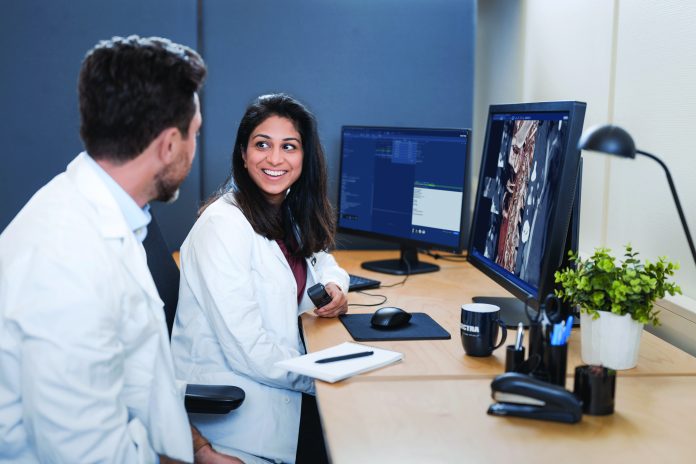Johan Carlegrim, President of Sectra Medical Education, discusses the value and necessity of incorporating advanced diagnostic imaging tools and realistic simulations into the medical curriculum to enhance the learning process for students and improve staff retention in healthcare
I have spent my whole working life focused on implementing innovations within diagnostic imaging. Together with many of the world’s leading healthcare organizations, I am driven by a shared belief that our work can help healthcare systems cope with the enormous increase in imaging exams and resource challenges so that we can continue to rely on this keystone of healthcare. Imaging exams, in the shape of an X-ray, MRI, gastroscopy video, or a digital pathology slide, for example, play a vital role across nearly all areas of medicine, offering critical insights into patient care – from diagnosis through treatment and follow-up. This often pixel-based information is an essential part of the patient record, and modern healthcare organizations implement enterprise-wide IT systems to handle this data and ensure it is available throughout the patient’s journey. For the most image – and resource-intensive departments, including radiology, pathology, cardiology, and orthopedics, these highly advanced systems are crucial in achieving the clinical workflow efficiency required to cope with the massive demand.
A workforce crisis
Most people are tired of hearing about healthcare resource challenges. Nevertheless, we are in the middle of a cataclysmic situation for the welfare system. Within diagnostic imaging, the aging population, and the growing prevalence of chronic diseases, the demand for these services is vastly increasing. As a result, I daily see examples of how the diagnostic imaging workforce is hugely overstretched, with severely negative consequences for them and their patients. Unfortunately, the future resource situation looks even more dire as imaging exams are expected to continue to grow significantly faster than the supply of diagnosticians, and the current workforce is skewed toward professionals nearing retirement age. In the US, of the 20,970 radiologists engaged in active patient care, more than half are aged 55 or over. (1) The situation is similar in the UK, and in low – and middle-income countries, the shortage might be even more acute, with rural areas suffering the most.
Within radiology, the challenge goes well beyond the radiologists focused on reviewing the exams for diagnosis. The people producing the imaging exams are another major concern, with more than 80% of healthcare facilities surveyed by the Advanced Health Education Center in 2021 struggling to fill open positions for radiographers (radiologic technologists). (2) Without radiographers, resolving the resource issues in other roles will not help. British universities report that there were not enough students to fill places on diagnostic radiography courses in 2021-22, and according to the Society of Radiographers, more than one in five of the radiography students dropped out of their courses during the same period. (3) The medical educators we work closely with all attest to the growing challenge of gaining and maintaining the students’ attention, as well as keeping them effective and engaged in the healthcare system over time.
Simulated diagnostics – a part of the solution
When speaking to medical students, it’s clear they are eager to grasp their future role’s meaning and its positive impact on patient care early on. The younger generation seems not only to be impatient but also highly purpose-driven. An excess of theoretical study, when disconnected from practical application, tends to disengage and demotivate students. Conversely, the aspect of medical education most valued by students is the opportunity for hands-on practice that closely mirrors real-life scenarios. Within radiography education, OsloMet University in Norway has been able to defy the broader trends of insufficient applicants and retention. By ensuring students have online access to the latest diagnostic imaging tools and learning material, both on campus and during clinical placements, the university experiences very low attrition rates. It has no difficulty filling the spaces in its radiography program. It seems that teaching students with 20-year-old technology no longer meets the contemporary demands of medical education.
In our experience with top US teaching hospitals’ radiology departments, medical students on clinical rotations are most excited about transitioning from observers to hands-on diagnosing using actual tools and imaging data. However, this is practically challenging since they cannot directly engage with current patient cases. In some encouraging examples, the solution has been to allow each student access to practice diagnosing patients using a fully realistic cloud-based diagnostic simulation platform stocked with real anonymized cases. This sandboxed solution significantly boosts the learning experience, cuts down supervision time, and standardizes training by guaranteeing equal access to high-quality education for all students. For universities, it also offers extra advantages by addressing clinical placement shortages. Realistic simulations in the curriculum can mitigate the problem of limited clinic training spots, potentially allowing more students to be accommodated.
Embracing life-long learning
Just ten years ago, it would have been impossible to learn in medical school how AI has a profound impact on digital pathology today, just like students or their teachers (or anyone) have little knowledge about how it will be in another decade. As the pace of technical innovation and research keeps accelerating in medicine, not the least in diagnostic imaging, innovations and advancements in medical practices must be adopted at a higher rate than today, and a fundamental shift of mindset is required. A successful career and healthcare practice requires learning to go from being a preparatory phase to an integral, inseparable component of the healthcare process.
Being at the forefront of this development and offering ongoing learning opportunities has already become critical for many healthcare institutions to make sure they maintain competitiveness and effectiveness. Leading teaching hospital chains in the US now regard platforms dedicated to continued medical education as critical strategic assets. These initiatives are imperative not only for enhancing the overall quality of healthcare delivery but also for attracting and retaining staff in highly competitive and shortage-stricken fields. By prioritizing and investing in realistic simulation tools and processes for continuous education, healthcare providers underscore their commitment to excellence and innovation, and it positions them as employers of choice for healthcare professionals who are eager to advance their skills and knowledge throughout their careers.
References
- Montecalvo R. Radiologist Staffing Trends 2021. V Rad. Feb. 18, 2021
- Radiology Staffing Shortages Nation Wide? – AHEConline Blog
- Supporting students: How to address the radiography workforce crisis | SoR

This work is licensed under Creative Commons Attribution-NonCommercial-NoDerivatives 4.0 International.











